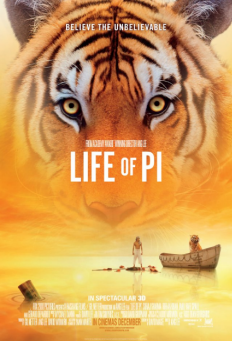Print Edition: November 28, 2012
 There isn’t a counter to its message Life of Pi hasn’t worked out a response to, posited within a conceit of simple, childlike storytelling, but effective more as a silencer of anything but conditioned awe. Spending most of its first third on a belaboured situation within a realistic, Canadian setting, Pi (Irrfan Khan) tells his tale to a prospective author (Rafe Spall) with a dignified mysticism, with the pretense, in response to the claim that “I was told you had a story that would make me believe in God,” of “I will tell you my story, you decide what you want to believe.” It’s a statement of defence, of the possibility of openness, but Life of Pi proves by its action and its use of words to be an isolated, closed experience.
There isn’t a counter to its message Life of Pi hasn’t worked out a response to, posited within a conceit of simple, childlike storytelling, but effective more as a silencer of anything but conditioned awe. Spending most of its first third on a belaboured situation within a realistic, Canadian setting, Pi (Irrfan Khan) tells his tale to a prospective author (Rafe Spall) with a dignified mysticism, with the pretense, in response to the claim that “I was told you had a story that would make me believe in God,” of “I will tell you my story, you decide what you want to believe.” It’s a statement of defence, of the possibility of openness, but Life of Pi proves by its action and its use of words to be an isolated, closed experience.
Religion has more meanings than can be discussed here, but Life of Pi makes it easy by plucking the most superficial, meaningless one. That is, religion as a set of tenants and stereotypes (Hindus have a lot of gods, Christians ornamental churches, Muslims the multiple daily prayers and journey to Mecca, Buddhists an affinity for simplicity, non-confrontation, and rice) without any inquiry into the actual thought and complicated searching that goes on within the parameters of any doctrine.
For a film to not be able to render real the most untouchable of impulses–belief–wouldn’t be a crippling problem, except that David Magee’s script never lets us forget this is the foremost thing Life of Pi is concerned with. Excruciatingly detailed voiceover tells a life story in a way that can only have come from a literary source, gathering strength of authority by listing, rather than being, an approach summed up in a montage of young Pi flipping through literature for meaning, comprised of close-ups of book covers – Dostoevsky, Camus, name dropping as shortcut to significance.
At one point, Pi’s story is shown to leave his listener speechless, a pointless inclusion that is self-ingratiating and nothing more. Fielding questions of plausibility and thematic resonance, Life of Pi’s framing device isn’t a single misstep but a pointer to the whole. For a recent example, where in Looper engagement with an audience through extratextual dialogue was a necessary clearing away, directing attention, in Life of Pi it is condescending, shallow and altogether ineffectual.
Aesthetics are where Pi finds religion (comic books, carvings, paintings, the appearance of ritual), and perhaps the defence for Life of Pi rests in that even if its words are generally awful, it speaks the language of belief in visuals. Director Ang Lee (Crouching Tiger, Hidden Dragon, Hulk) goes fully digital, giving the earlier segments of conversational visits the sheen of home video carelessness and making the deliberately symmetrical story of “art” within resemble a particularly lengthy video game cut scene. Surely James Cameron is to thank for part of this, but Lee and cinematographer Claudio Miranda (of the similarly sterile Tron: Legacy) revel in the ease of copy-pasted unphysical creation, limited only by the frequent recurrence of “gorgeous” shots of glassy, reflective water surfaces and its rainbow-spectrum CG creatures in heroic arrangements. A thousand dolphins here and a million meerkats there just because it can be done, an over-determined glow of point-and-click composition to every shot, is the visual ethic here. In Life of Pi’s first intrusion of digitally-possible long takes and magical happenstance, the effect isn’t as tiresome, but as a storm rocks a boat, and the camera latches onto the hull, the obvious is made even more so – Ang Lee’s money shot swimming pool would be perfectly suited to being the installed video component of an amusement park ride.
Cast away stories are nothing new, certainly not as worked for the screen here, and religious statements certainly less so. Perhaps ones designed to be in 3D with objects flying at the screen (there’s even an aspect ratio shift at one point to accommodate more depth of said projectiles) could be said to be, but Life of Pi doesn’t stop there. Along with its spectacle, Life of Pi is another dreadful “Why we tell stories” story, gravely dishing out the hard truth, even as it invokes and makes use of Pavlovian conditioning and cynical “for your enjoyment” mockery – it either can’t see through its own disguise or is very near to insidious in its children’s book pontificating.
Your own opinion on religion, art and digital versus traditional means will determine a lot of what is perceived with this movie, but Life of Pi is in a major way an undeniable work. A dream of open dialogue never exists here – this is authoritative, blaring choir, camera as battering ram Message moviemaking. While its focus might purport to be expansive, and its beacon universal, Life of Pi is completely alone, a soulless environment – a movie that inspires no reflection. In its “beauty,” the best description would not be pop-art, and it can’t be simply dismissed as faux-art; it’s just easily comprehensible art, art with an endpoint, the worst and least active of all.


